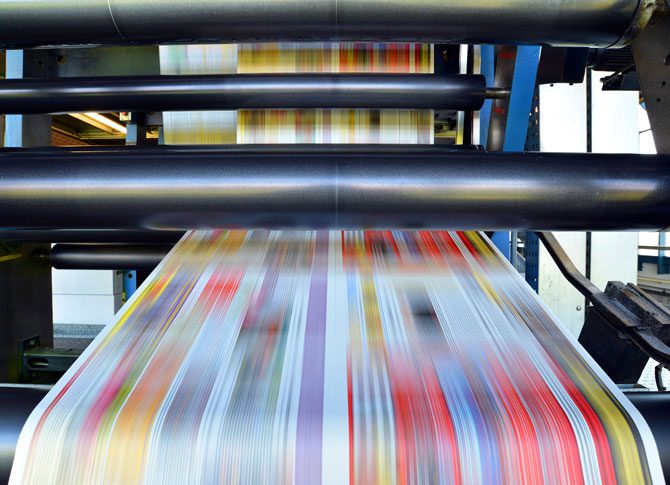There are various reasons it might not be feasible to print barcode labels in your facility—extremely high volumes, real estate constraints, and specialized requirements are just a few.
When ordering pre-printed labels from a supplier, you’re going to need to be sure their offerings can meet your needs. Different print technologies suit different applications, which is why it’s so important to find a supplier who’s familiar with your industry.
Here, we’re going to take a look at three print technology options we offer our customers who purchase pre-printed labels.
All three provide high image quality and superior color, but they also each have strengths and weaknesses that make them better suited to different applications. Let’s talk about those differences and why your supplier might recommend one technology over another for your application.
Flexographic printing
Flexographic printing transfers ink directly onto the material substrate. Flexible printing plates are mounted on quickly-rotating cylinders. Ink is deposited as the media travels beneath.
Flexographic printing is tried and true—it’s been around for over a century! With it’s evolution over time it remains one of the most popular ways to print visually appealing color labels.
Through the use of continuous stock material on large rolls, flexo printing allows for quick throughput speeds, resulting in a cost-effective way to print high volume jobs.
Like digital offset, over-laminates and topcoats can be required if the application environment is stringent. This type of imaging technology can crack under the pressures of extreme temperatures or chemical exposures.
The most prominent limitation of flexographic printing is the inability to accommodate variable data. The plates must be prepared ahead of time allowing them to print only a single image. While this makes it perfect for ensuring a consistent image—let’s say, a logo—it won’t be a great fit for situations where each label needs to contain different information.
We recommend flexographic imaging technology for jobs that are large in size (hundreds of thousands of labels at a time) and require vivid color for color-coding or customer logos but don’t require variable data.
Digital offset printing
This method is described as “offset” printing because a few steps have to occur before the image is applied to your media—let’s break them down:
- The imaging plate receives an electrostatic charge.
- The discharged areas on the plate receive ink.
- The ink is transferred from the charged imaging plate to a heated blanket.
- The inked image is transferred to a photo drum.
- Finally, the image is transferred to the substrate.
The resulting thin layer of ink features 812 dpi image resolution and vivid color if you choose. The high resolution makes it a great choice for ensuring scannability of barcodes of all sizes and color allows for color-coding, logos and other graphics.
While crisp clear imagery and rich colors are strengths of this technology, it can fall short when it comes to resistance to chemicals and abrasion. Topcoats and laminates are often used to alleviate these concerns so labels printed with digital offset technology can go on to survive water baths, chemical exposures and extremely cold temperatures.
Digital offset printing can process four colors at a time at speeds of up to 200 feet per minute. The high speed capabilities make it a great choice for customers with large runs requiring variable data or a high-mix/low-volume product mix. We typically run our printers at speeds between 90 and 170 feet per minute depending on various factors to maximize image quality.
At Computype, we pair this technology with our Vision System, which scans each barcode as it’s produced, checking for imaging errors to ensure customers get perfect barcodes every time.
UV inkjet printing
Strategically positioned nozzles precisely eject thousands of ink drops per second onto the substrate during the UV inkjet printing process.
After the image has been set, a UV light cures the ink, ensuring a durable mark capable of surviving harsh exposures, such as common lab chemicals, without needing an over-laminate or topcoat.
One of the primary benefits of UV Inkjet printing includes the impressive throughput speeds of up to 164 feet per minute, making this an efficient way to process color printing jobs. Additionally, there is greater flexibility and economies of scale for customers requiring high-mix/low volume, color labels because there aren’t minimum color constraints.
While these features may be impressive, UV-inkjet isn’t suitable for certain healthcare applications such as blood collection. The UV light poses a risk to the integrity of human samples. For this reason we recommend digital offset printing to those whose samples or donations need to meet specific FDA safety guidelines.
UV inkjet technology has a faster registration and typically provides more consistent output than other printing methods. Just as with digital offset, we recommend this technology to customers with large runs, variable data or low-volume/high-mix needs.
It’s also a great fit for labels requiring multiple colors and pristine image clarity regardless of volume or data needs. The only major limitation is for those who need to meet specific FDA safety guidelines.
Key takeaways
All three of these technologies are great options for various applications, which is why we choose to offer them to our customers. They can provide high image resolution, include vibrant colors, accommodate high volumes and withstand exposure to extremes of heat and abrasion (though some need a little help.)
In summary, digital offset is best suited to high or low volume, high mix color jobs and is suitable for situations where special safety requirements may need to be met—such as labels for human samples.
UV inkjet is a great match for high-mix jobs of various sizes especially when those labels will face harsh environmental conditions.
Flexographic printing is best suited to high-volume color print jobs that don’t require variable data.
Regardless of your needs, Computype will work with you to determine the most efficient and economical means of producing your labels in order to accommodate your processes and budget.

